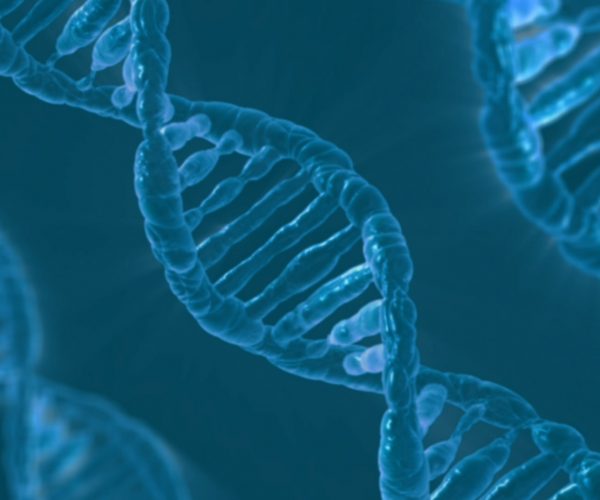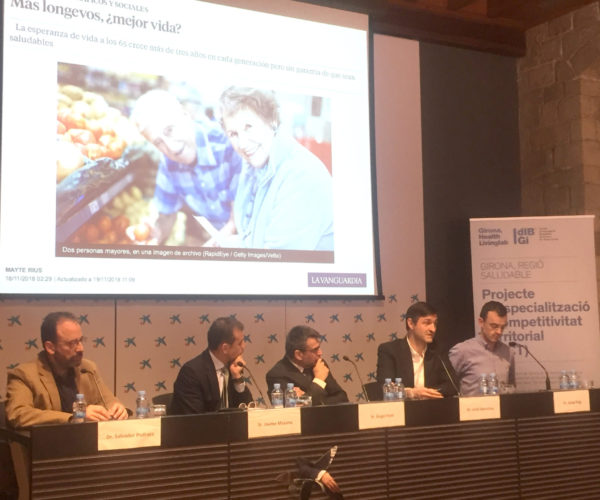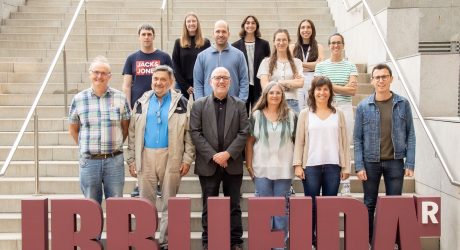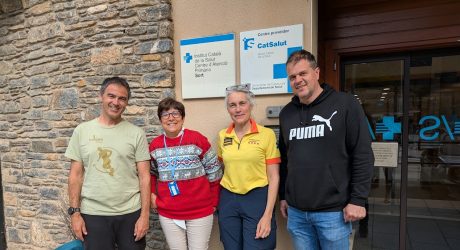IDIBGI closes the first stage of “Ageing Imagenome” project that will provide more than 10 million data
The “Ageing Imagenome” project ended the first phase of recruitment and data collection, with the exhaustive study of 1.030 volunteers. The analysis of this information will allow to obtain more than 10 million data in order to identify aging patterns.
This morning, the project presentation was supported by Mr. Àngel Font, corporate director of Research and Strategy of Fundació Bancària “la Caixa”; Mr. Jaume Masana, territorial director of CaixaBank in Catalunya; Dr Jordi Barretina, director of l’Institut d’Investigació Biomèdica de Girona (IDIBGI), and the researchers of the Medical Image Research Group, Dr Josep Puig, principal investigator of the “Ageing Imagenome”, and Dr Salvador Pedraza, Head of the group and co-researcher of the project.
All of them highlighted the relevance of this initiative, one of the most comprehensive at international level, and the massive data collection that may allow to determine different ageing patterns or behaviors. In summary, it will generate a knowledge that would help to place the focus of the elderly people health care into the more relevant topics of health, that could lead to a faster decision making and to focus health expenses to the more convenient features for the population.
A massive data collection
These data were obtained from the exhaustive study of 1.030 participant volunteers that was focused in the integral corporal image collection with magnetic resonance, but also anthropometric data, biological, etc., like weight, height, blood pressure, diet and physical activity, an electrocardiogram, an echography of the carotid artery, blood, urine and intestinal microbiota analyses, and several neuropsychological tests.
The volunteers of the Girona region were chosen from two population studies, the SHARE and the MARK (also with cardiovascular criteria).
Dr Barretina declared that “Girona is the ideal area to develop this kind of studies, as we have one of the longest lifespans in the world. Also, IDIBGI and their researchers, from different research areas, will allow a multidisciplinary action, extremely useful in studies like this one”.
Dr Josep Puig, radiologist of the l’lnstitut de Diagnòstic per la Imatge (IDI), IDIBGI researcher and project leader, highlighted the magnetic resonance as an ideal tool for the study of different organism parts (brain, spine, heart, abdomen, aorta, fat tissue and muscular groups) with hundreds of images. As he said, “In the magnetic resonance study we did not use contrast media, thus the study was free of associated secondary effects and will allow a global, integral and holistic analysis of the organism, from the structural, functional and metabolic points of view”.
Public-private collaboration
Due to the complexity of this project a network of collaborators, entities and companies was required to guarantee the success. With an investment of more than one million euros in research in the region of Girona, the project would not have been possible without this public-private partnership. Thus, IDIBGI has received funding from public funds from the Department of Health of the Generalitat de Catalunya, the transfer of mobile magnetic resonance equipment and ultrasound equipment by Canon Medical Systems, funds from Companies such as Olea Medical, donations from private institutions such as l’Obra Social “La Caixa” and the assignment of spaces by EUSES. The investigation undertakes with professionals of IDIBGI, the IDI and the Catalan Health Institute (ICS).




